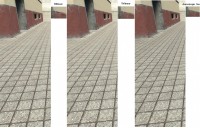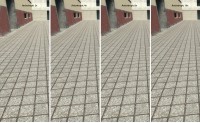Enhanced Trilinear filtering solving blurred textures.
Invented by: unknown
1st use: unknown
Mainstream use: 1999+ - with releasing DX7 GPU chips
Used for: increasing image quality
Replaced by: nothing yet
Trilinear filtering was better than Bilinear, but both of them produced blurred textures angled to camera and also some visual artifacts. Anisotropic filtering scales either the height or width of a mipmap by a ratio relative to the perspective distortion of the texture; the ratio is dependent on the maximum sampling value specified, followed by taking the appropriate samples. AF can function with anisotropy levels between 1 (no scaling) and 16, defining the maximum degree which a mipmap can be scaled by, but AF is commonly offered to the user in powers of two: 2x, 4x, 8x, and 16x. The difference between these settings is the maximum angle that AF will filter the texture by. That mean higher Anisotropic filtering = better textures at higher angled surfaces (usually objects far from player).
Nvidia supports Anisotropic filtering since releasing GeForce 256 card (1999). ATi have support since Rage 128 Pro (1999, GL and VR versions are not supported).
Anisotropic filtering depends on memory bandwidth and have also much higher performance hit. Even on highend gamer cards in 2003 it decreases fps by almost 40%.
 Angled textures (ground, wall) are sharp even far away from player and also disappeared red line (artifact created by filtering) on wall under blue line.
Angled textures (ground, wall) are sharp even far away from player and also disappeared red line (artifact created by filtering) on wall under blue line.More info at:
Wikipedia
Extremetech
GeForce
Tomshardware
Dev.mag
Bit-tech
OpenGL
You can also view video below showing differences between Bilinear, Trilinear and Anisotropic filtering.


